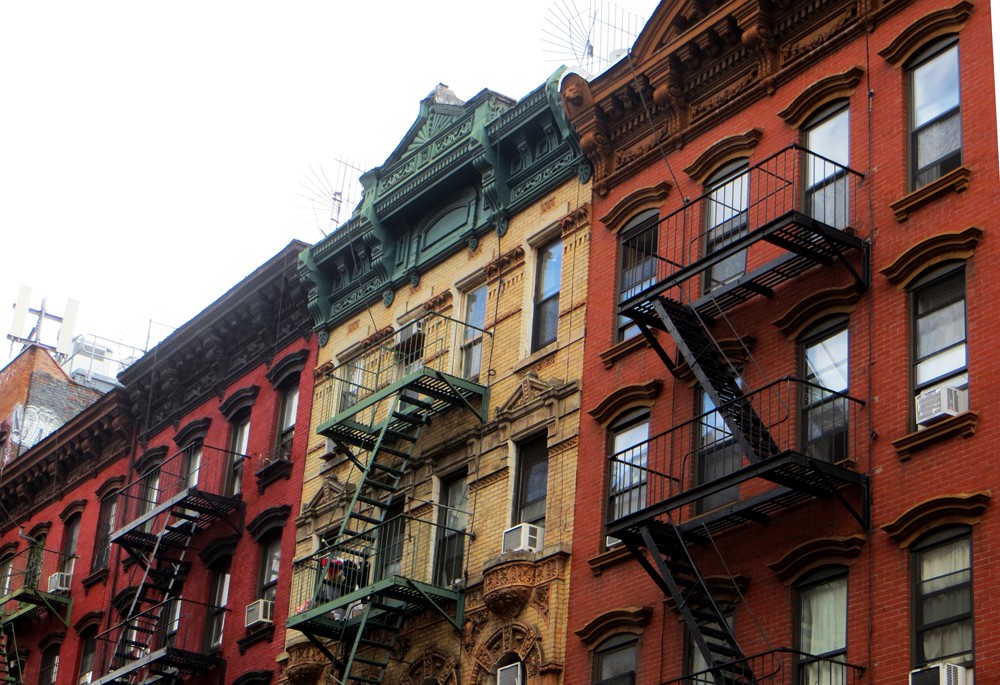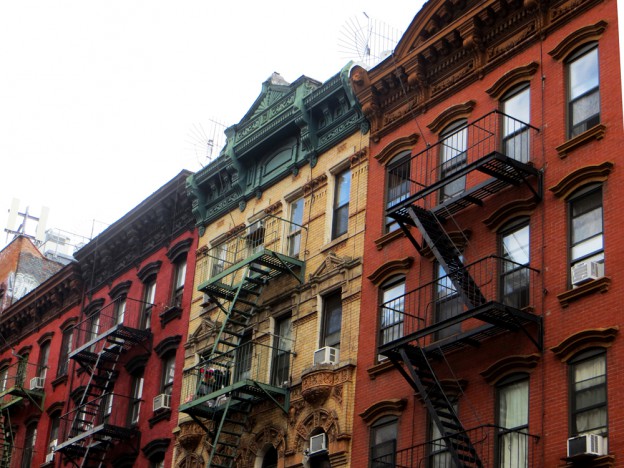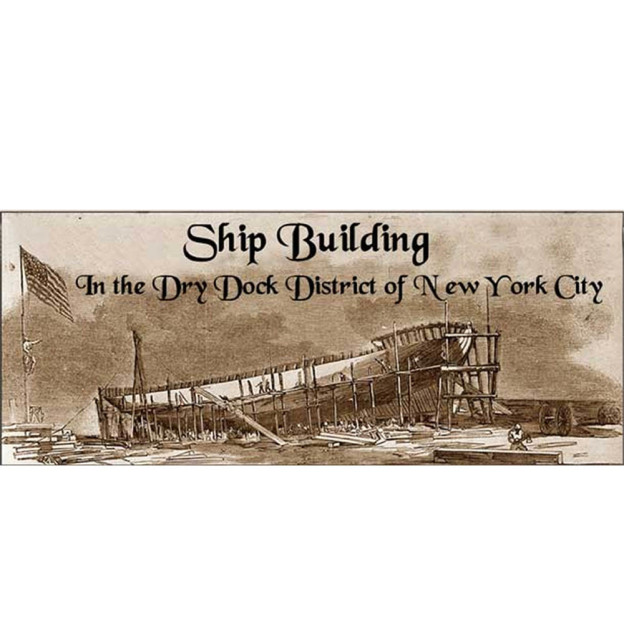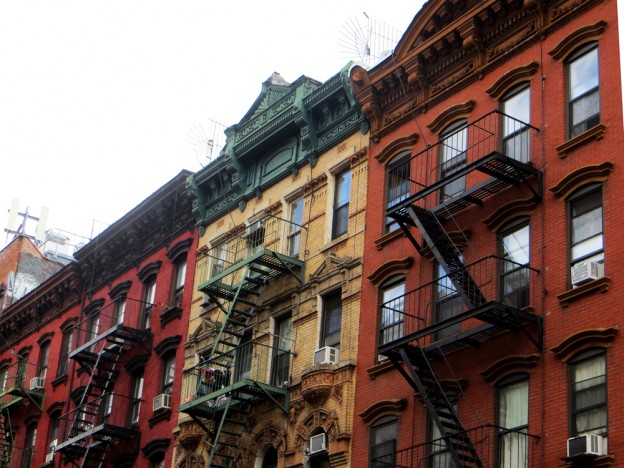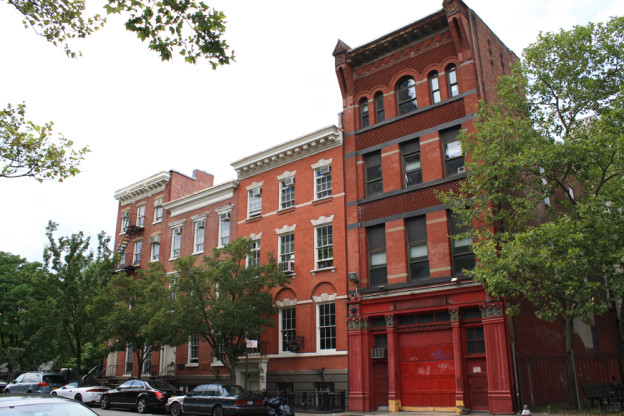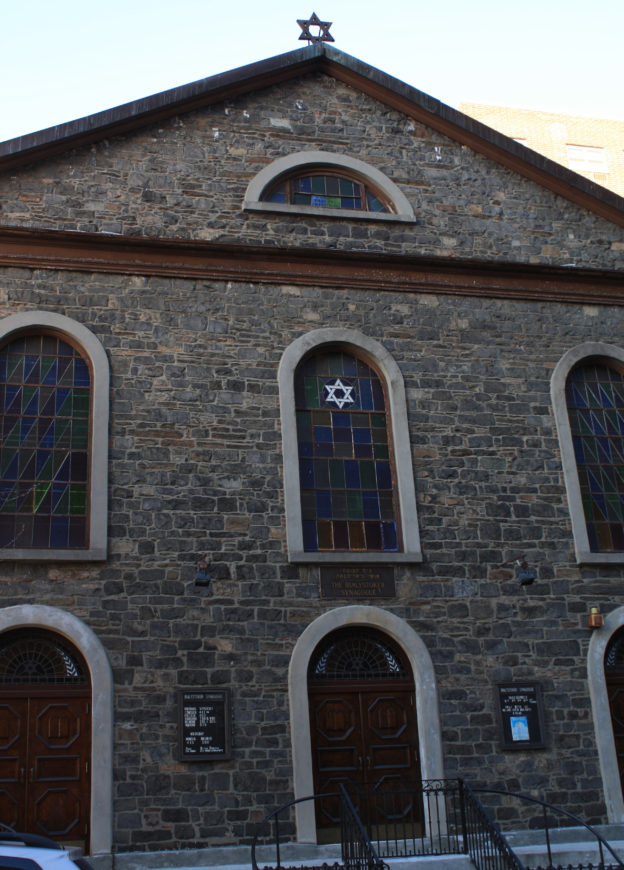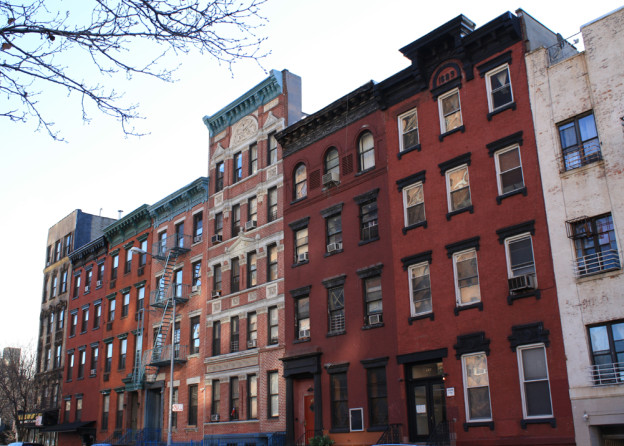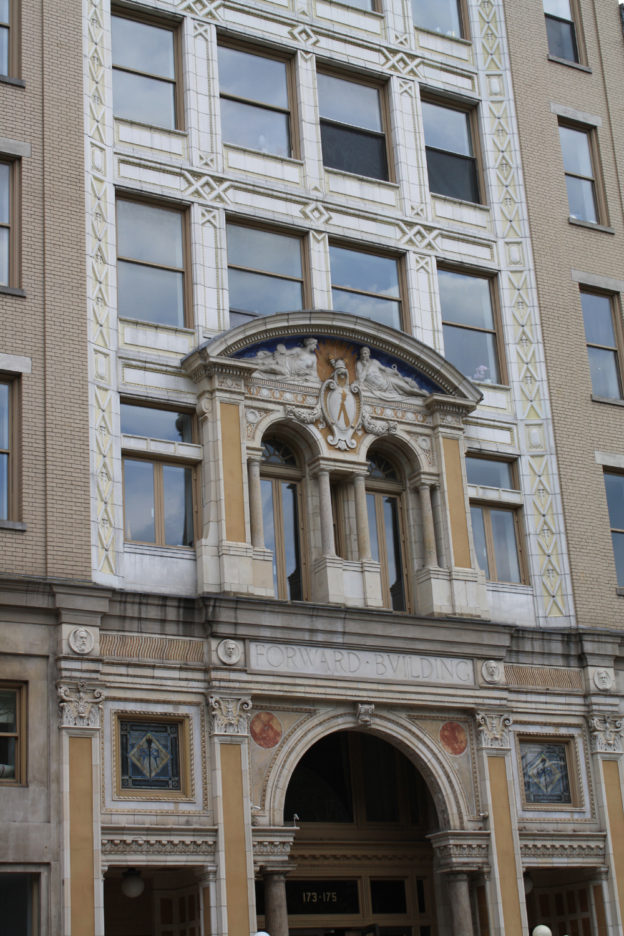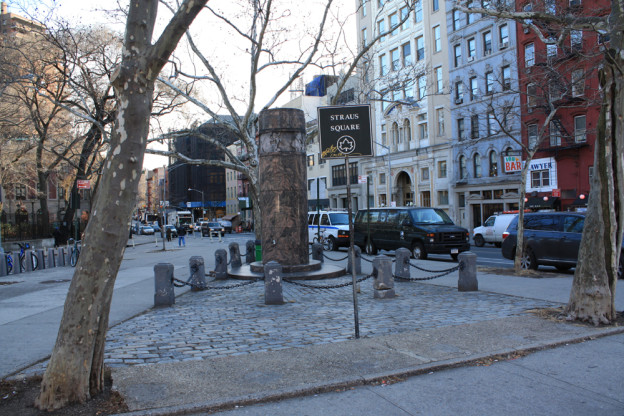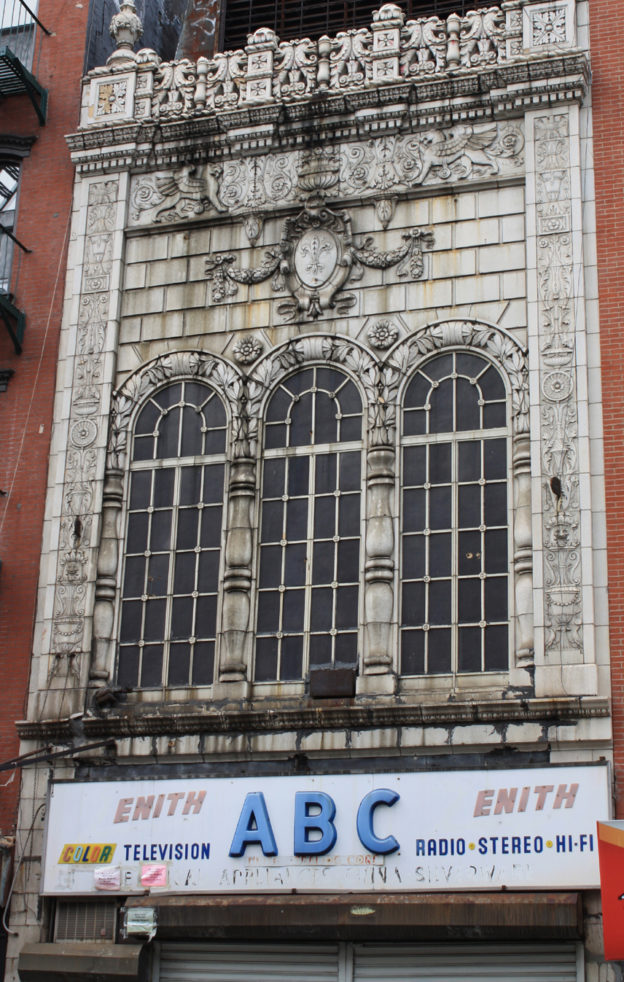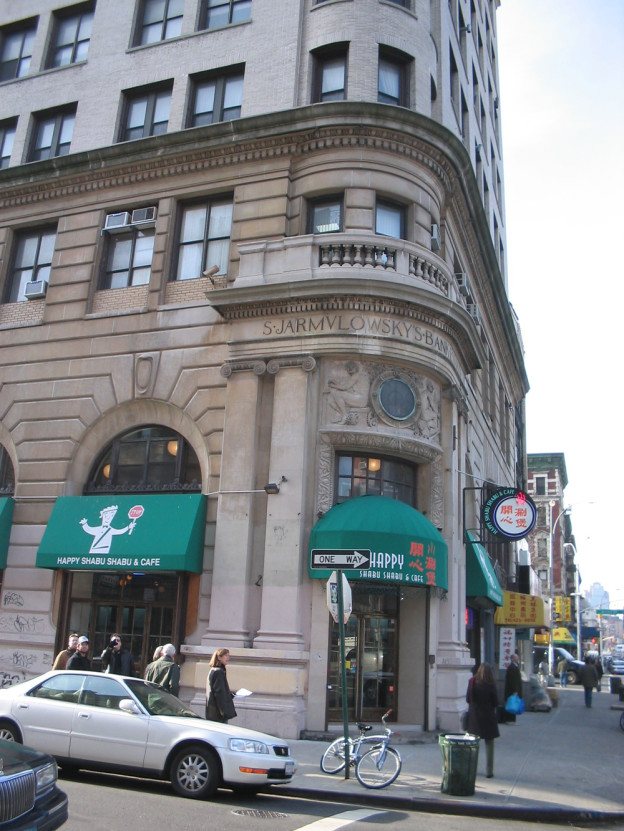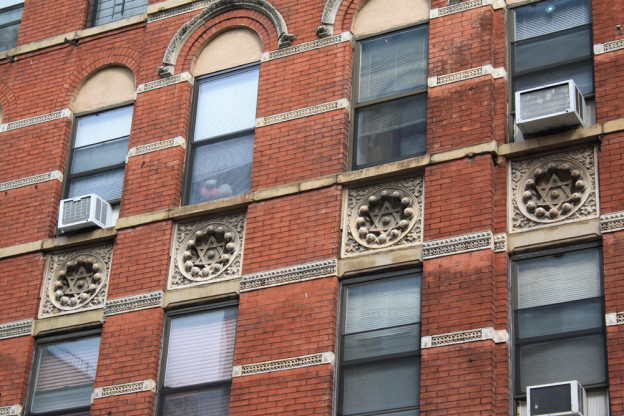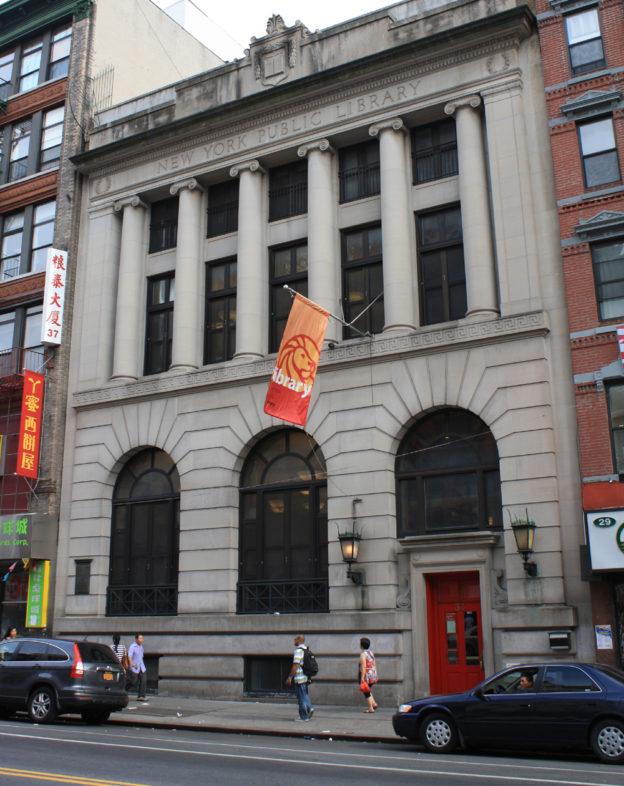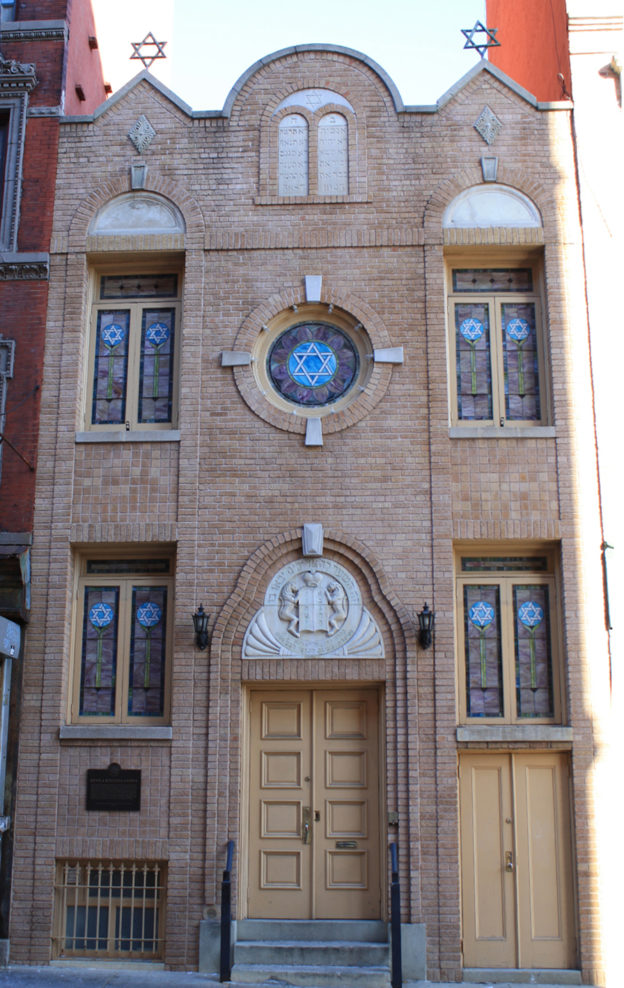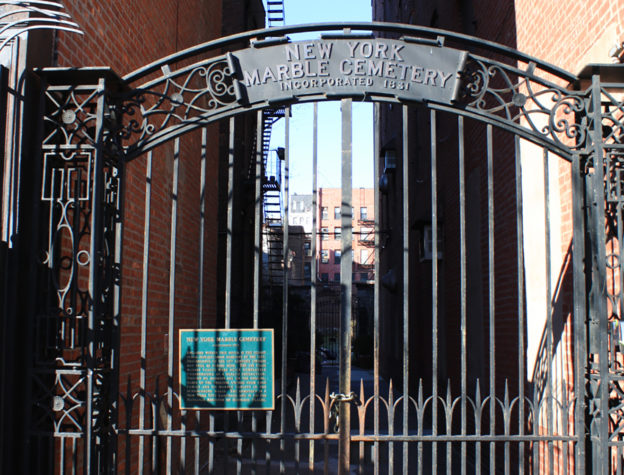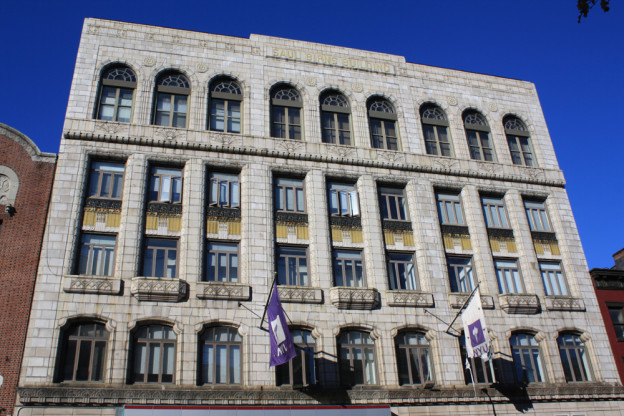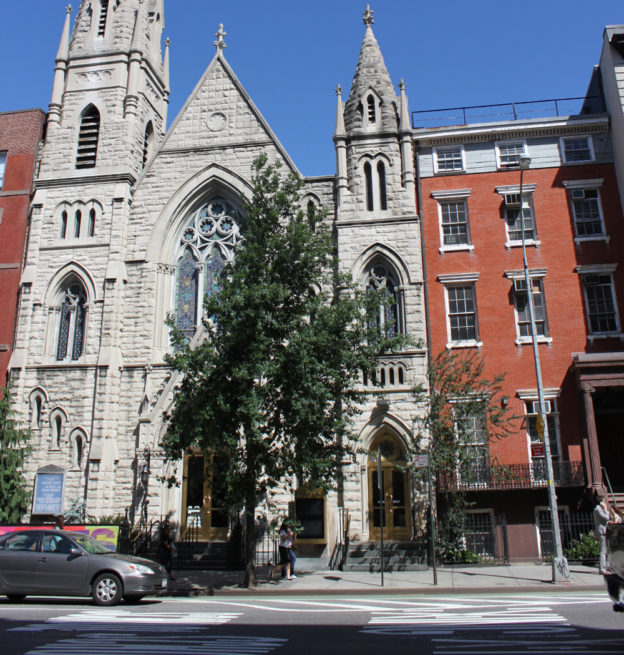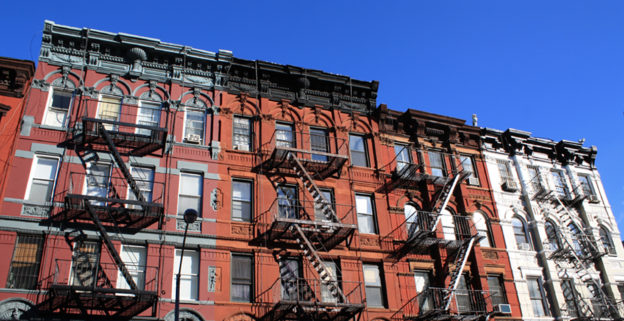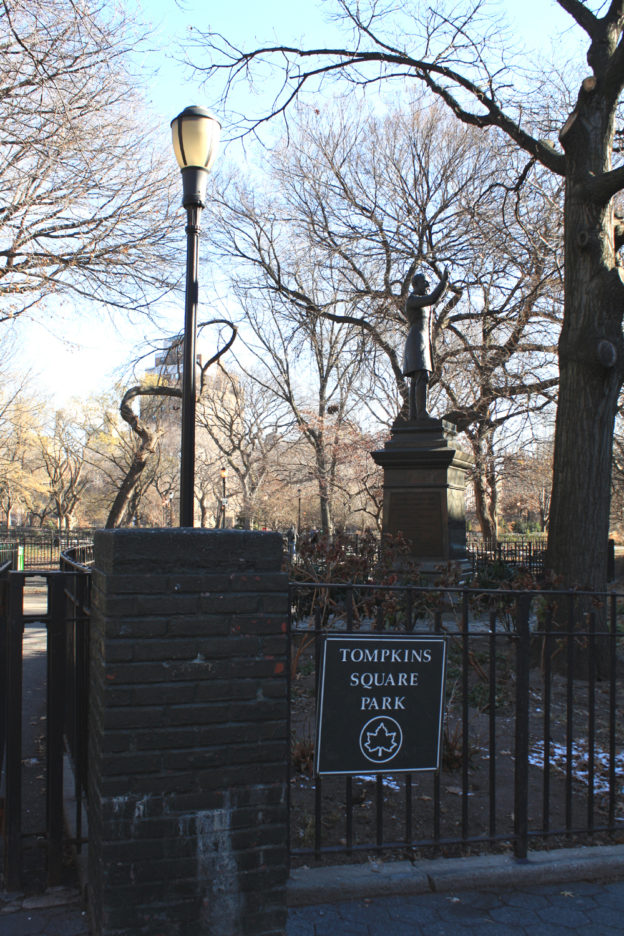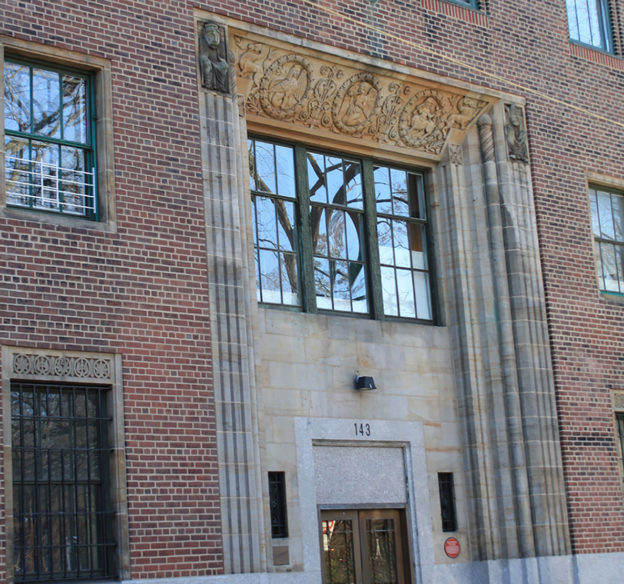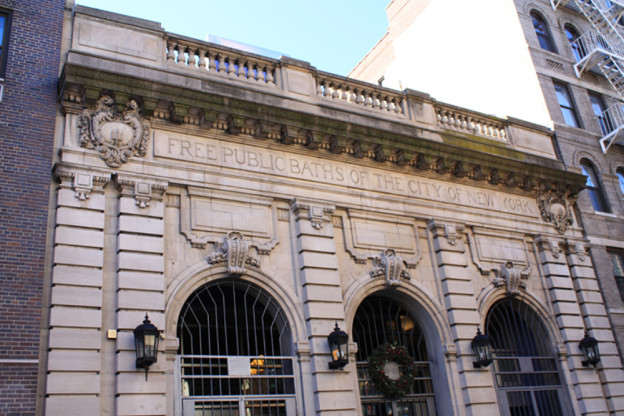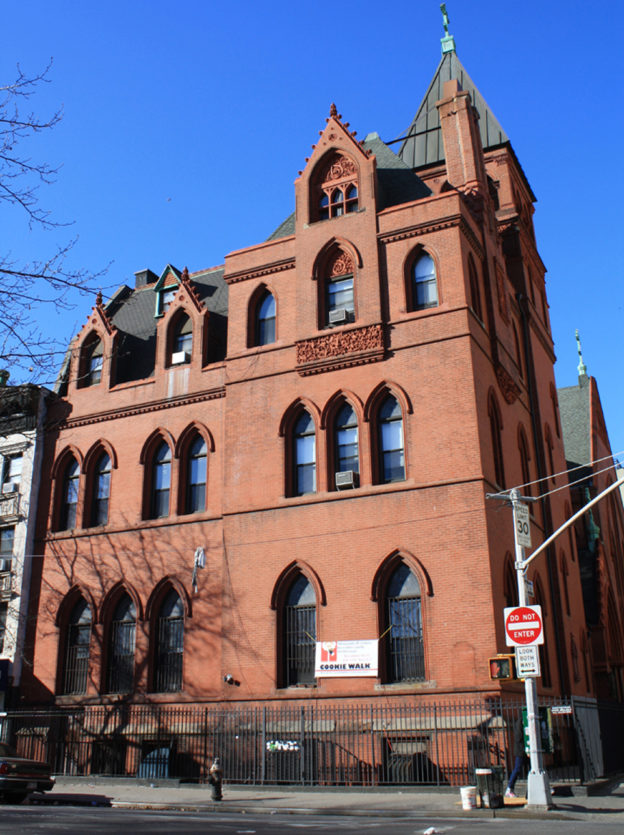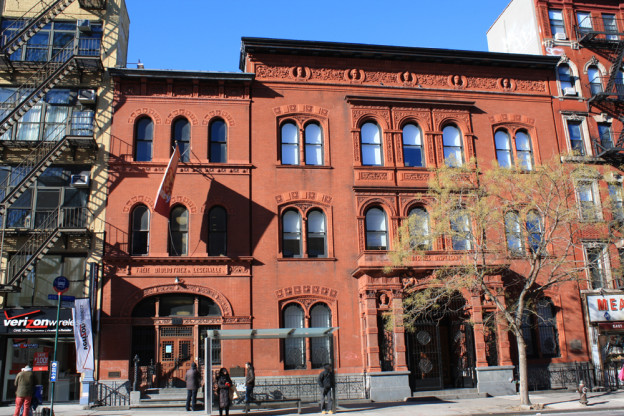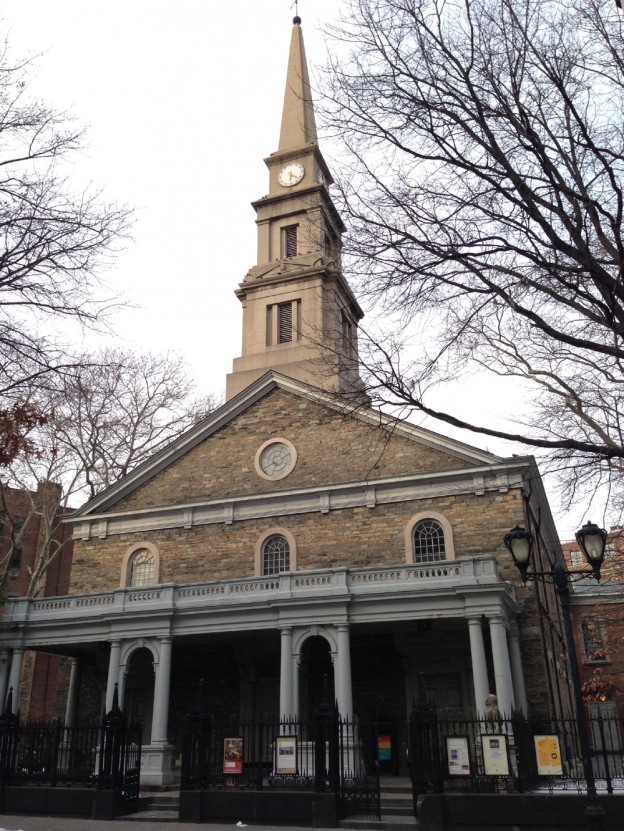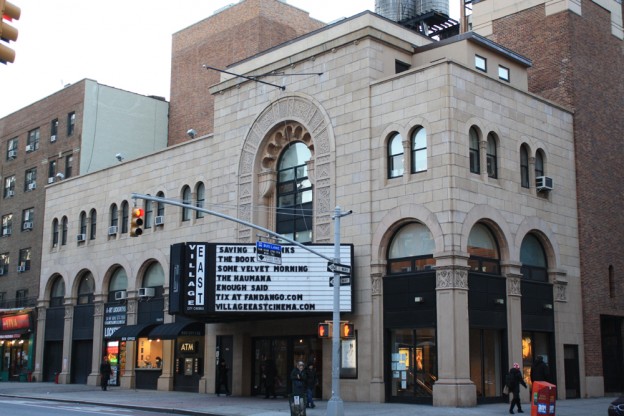Historically, the Lower East Side extended from East 14th Street south to Fulton and Franklin Streets, and from the East River west to Broadway and Pearl Street. Today, the regarded boundaries of the East Village and Lower East Side extend roughly from East 14th Street to the Bowery to the East River, with Houston Street as their north-south divider.
The area’s architecture reflects its early development, with extant examples of early 19th century rowhouses, religious structures, theaters, schools, libraries, banks and settlement houses and the tenement. The East Village contains three New York City historic districts: St. Mark’s Historic District and Extension, East Village / Lower East Side Historic District and East 10th Street Historic District. The latter two were designated in 2012 after a robust advocacy and outreach effort by community groups and preservationists. At the time of this publication, there are no locally designated historic districts in the Lower East Side.
To learn more about East Village/Lower East Side click here
Lower East Side Preservation Initiantive &
Art Loisaida Foundation
present
LESPI presents Ship Building in the Dry Dock District in New York City
Thursday, January 29, 2015
6:30-8:30 pm
Neighborhood Preservation Center
232 East 11th Street
(btn. 2nd and 3rd Avenues)
presented by
Laura Zelasnic
Amazingly, what we now know as the East Village’s Alphabet City was part of a huge shipbuilding district, which during the 19th century produced and launched many of our country’s most beautiful and important ships – clippers, ironclads, steamships and more. There are now only a very few reminders left of this once thriving industry.
Come hear Laura Zelasnic reveal this fascinating history, wonderfully illustrated with period images.
Admission: $15 / $10 LESPI members
The lecture will be followed by a short reception. Light refreshments will be served.
For further information contact Richard at info@LESPI-nyc.org or 347-827-1846.
Seats are limited: reservations recommended.
Make a reservation online HERE.
This program is made possible in part by public funds from The NYC Dept. of Cultural Affairs in Partnership with the New York City Council-(Many thanks to Rosie Mendez, NYC Councilperson) and and the NYS Assembly in partnership with NYS Dept of Parks (many thanks to the Honorable Brian Kavanagh)
http://us2.campaign-archive2.com/?u=83f9475af0eb0d590581eb33d&id=6f3f82cdd8&e=250751cbe4
Presented by:
Marcia Haddad Ikonomopoulos
Director of the Museum at Kehila Kedosha Janina and LESPI Board Member
This program illuminates a little-known part of the American immigration story – that of the immigrants from Greece.
Step into the Balkan world of the Lower East Side, the kafenions and dance halls, the lilting bouzouki music and the aromas of Mediterranean cooking. Learn about the Sephardic and Romaniote synagogues and the local Greek Orthodox Church. They came during the massive wave of immigration (1881-1924) but their stories were very different.
Suggested donation: $15
Wednesday, October 1, 2014
6:30-8:30pm
Neighborhood Preservation Center
232 East 11th Street
(btw. 2nd and 3rd Avenues)
The lecture will be followed by a short reception. Light refreshments will be served.
For further information contact Richard at info@LESPI-nyc.org or 347-827-1846.
Space is limited RSVP are required – Make a reservation online HERE.

In Celebration of the First Annual Lower East Side History Month
Saturday, May 10, 2014, 12 noon – 2:00 pm
(Rain Date Saturday, May 17 – check website: friendsofthelowereastside.org)
Begins and ends on the Southeast corner of Delancey and Orchard Streets (F, J, M, Z trains to Delancey Street/Essex Street Station)
Cost: Free – Attendees MUST register by May 7 with all names to: friendsoftheles@gmail.com
“The Lower East Side is where millions of immigrants have taken their first steps in the New World on the road to the American Dream,” wrote Joyce Mendelsohn, our tour guide and author of the definitive guidebook to the area, The Lower East Side Remembered and Revisited. Although endangered, a number of blocks south of Delancey Street still retain the sense of place that would be familiar to our immigrant ancestors. The tour will focus on the history and architecture of the historic neighborhood with particular attention to the housing, institutions and businesses that were the center of immigrant life. The guided tour will highlight the impact of housing reforms reflected in the changes to the plans and features of tenements over time. “We will see pre-Old Law, Old Law and New Law tenements and look up at the elaborate terra cotta ornamentation that distinguishes many buildings,” said Mitchell Grubler, the tour’s co-leader.
The structures that housed some of the institutions and businesses which served the multitudes of immigrants will also be highlighted. The tour will pass a Neo-Renaissance style school designed by architect, C.B.J. Snyder in 1897; the former Independent Kletzker Brotherly Aid Society built in 1911; the 12-story former Jarmulowsky Bank of 1911-12; as well as a number of other significant buildings.

Howells & Stokes, 1898-99; addition: DeLemos & Cordes, 1904;
197 East Broadway Brunner & Tyron, 1889-91;
Henry Street Settlement: 301 Henry Street, DeYoung, Moscowitz & Rosenberg, 1962;
263 and 265 Henry Street, 1827;
267 Henry Street, 1834, new façade: Buchman & Fox, 1910;
Engine Company No. 15, 269 Henry Street, Napoleon LeBrun & Sons, 1884;
281 East Broadway, 1829|
The Settlement House movement began in the 1880’s in response to worldwide urban poverty sparked by industrialization and immigration. Settlement houses provided education, recreation, medical services and social welfare programs to residents of city slums. The Neighborhood Guild, founded in 1886 as America’s first settlement house, brought male university graduates to the Lower East Side to help and inspire the poor. The Guild changed its name to University Settlement in 1891. Founded by Jewish philanthropists, the Downtown Hebrew Institute was founded in 1889 to transform new Jewish immigrants into assimilated members of their new society. Its name was changed to the Educational Alliance in 1893. Many settlement houses were staffed by educated women, including the Henry Street Settlement, which was founded in 1893 by advocate Lillian D. Wald and funded by Mrs. Solomon Loeb and her son-in-law, banker and philanthropist Jacob Schiff. All three of these settlement houses are still in operation today. In 2007, Henry Street Settlement acquired Engine Company No. 15, one of many firehouses designed by Napoleon LeBrun & Sons and commissioned by the City between 1878 and 1894. The site has a storied past, as it was previously home to a brownstone dwelling converted in 1854 into the Americus Engine Company No. 6, or the “Big Six”, which William M. “Boss” Tweed organized and used as a vehicle for his infamous political exploits. Each of the Henry Street Settlement address are New York City Individual Landmarks. 263 and 265 Henry Street and 267 Henry Street are both listedon the State and National Register of Historic Places.
7-13 Bialystoker Place, 1826 – NYCIL & Nat’l Reg Property;
290 Henry Street, contributed to John Heath, 1827-29 – NYCIL & Nat’l Reg Property|
These two churches, located a few blocks apart, are two of the four surviving fieldstone religious structures built in the late Federal era in lower Manhattan. Their fieldstone was quarried from Mount Pitt, a hill that once stood at the present corner of Pitt and Grand Streets. Their simple exteriors give way to ornate and fascinating interiors. Bialystoker Synagogue, originally the Willett Street Methodist Episcopal Church, has a richly hued interior with statuary and paintings. A concealed corridor discovered during renovations in the 1990’s led to speculation that the building was a safe house on the Underground Railroad. St. Augustine’s, originally the All Saints’ Free Church, houses the old High Altar from Trinity Church, the Lady Altar from St. Augustine’s Chapel on East Houston, the pulpit from the demolished St. John’s Chapel in Hudson Square, and enclosures around the organ that were once designated seating for black parishioners. Both churches are New York City Individual Landmarks and listed on the State and Nation Register of Historic Places.
c. 1837|
These Greek Revival rowhouses are rare survivors of their period of construction in the early 19th century, and stand as reminders of the time before large numbers of immigrants began settling into the Lower East Side. Each house was built for a single wealthy family, as evidenced by the fancy ironwork on number 247.
173-175 East Broadway, George A. Boehm, 1912|
Located on a stretch of East Broadway once known as “Yiddish newspaper row”, this was the headquarters for Vorwärtz, or the Jewish Daily Forward, the most widely read Yiddish newspaper in the United States. First published in 1897, it was immensely influential on the Jewish community for its support of socialist causes and for its articles offering advice on everyday struggles, making the most of America’s opportunities and encouraging children’s education. The terra cotta-clad building features medallions with faces of socialist heroes Karl Marx, Friedrich Engels, Karl Liebknecht and Ferdinand Lassalle above the entry, Vorwärtz in Yiddish at the building’s crown, and a clock at the parapet. The paper moved uptown in 1974 and the building was converted to condominiums in the 1990’s. The Forward Building is a New York City Individual Landmark.
Canal Street to Hester Street, between Essex and Jefferson Streets established 1899;
Straus Square, intersection of East Broadway, Essex, Canal and Rutgers Streets|
In the late 1890’s, the Outdoor Recreation League lobbied the City to clear several blocks for Seward Park, which opened in 1899. The park was named for politician William H. Seward, a strong supporter of immigrants, who in turn supported his successful campaigns for State Senate, Governor and U.S. Senate. The City took over management of the park in 1903 and created a permanent municipal playground, the nation’s first. The park also featured a children’s farm garden and a public bathhouse, which was replaced in 1941 with a recreation building. Straus Square was originally named for patriot Henry Rutgers, whose hundred-acre farm was nearby. Both Henry and Rutgers Streets and Rutgers University are also named for him. The square was a political epicenter, regularly hosting rallies and demonstrations. In 1931, the square was renamed for German Jewish philanthropist and advocate Nathan Straus, whose family owned Macy’s and Abraham & Straus department stores.
31 Canal Street;
Thomas W. Lamb, 1926-27|
This movie house was designed in the Spanish baroque style and originally held 2,270 seats, offering a welcome distraction and escape from daily life in the tenements until it closed in the 1960s. The glazed white terra cotta façade, dominated by three arched faux windows in the center, is graced with rich Classical ornament in the form of wreaths, urns, griffins and foliage. The Former Loew’s Canal Street Theatre is a New York City Individual Landmark.
54-58 Canal Street;
Rouse & Goldstone, 1912; redesign: William F. Coates, 1933|
Sender Jarmulowsky, an immigrant financier, established a bank in an existing building on this site in 1873, but replaced it with this 12-story Beaux-Arts tower in 1912. The building features a rusticated limestone base, terra cotta ornament and, until the 1990s, a domed temple-like cupola on top, which was a defining element of the Lower East Side skyline. The bank served neighborhood residents until it was forced to close in 1914 after being unable to meet patrons’ withdrawal demands at the outbreak of World War I. As federal insurance for banks did not exist yet, the economic burden of its closure fell on depositors, and a riot broke out in the street. The Former Jarmulowsky Bank is a designated New York City Individual Landmark.
97 Orchard, architect unknown, 1863-64;
14-16 and 47 Orchard Street, Herter Brothers, 1887|
Named for a grove of fruit trees on the DeLancey estate that comprised much of this area, Orchard Street is characterized by its tenements and history as a commercial thoroughfare, hosting many prosperous shops and street vendors. The five-story pre-law tenement at number 97 was purchased by the Lower East Side Tenement Museum in 1988 to interpret the history of immigration to the area. It is estimated that roughly 7,500 people from 25 countries resided in the building until it was sealed due to non-compliance with City housing codes in 1935. The six-story, red brick, Queen-Anne-style Old Law tenement at number 14-16 features a fanciful cornice and terra-cotta Stars of David, a feature shared by its sister building at number 47. 97 Orchard is listed on the State and National Register of Historic Places.
Tompkins Square Branch, 331 East 10th Street, McKim, Mead & White, 1904;
Rivington Branch, 61-63 Rivington Street, McKim, Mead & White, 1905;
Seward Park Branch, 192 East Broadway, Babb, Cook & Welch, 1909;
Chatham Square Branch, 33 East Broadway, McKim, Mead & White, 1903|
Businessman Andrew Carnegie funded the construction of 67 libraries in New York City between 1901 and 1929, and commissioned prominent architects to design them. Of the 57 still standing, four are located in the East Village and Lower East Side. Three of these were designed by McKim, Mead & White in the Classical Revival style: the Rivington, Chatham Square and Tompkins Square Branches. The Rivington Branch was the first library in the city to incorporate an open-air rooftop reading room, a feature that others soon copied. The Chatham Square and Tompkins Square Branches are grander, with arched window openings, columns and fanciful carvings. The Seward Park Branch was designed by the same architects responsible for Carnegie’s mansion on Fifth Avenue, and the two red brick and limestone, Renaissance Revival buildings bear a striking resemblance. The Tompkins Square Branch, Seward Park Branch, and Chatham Square Branch are all designated New York City Individual Landmarks. Tompkins Square Branch is located in the East Village/ Lower East Side Historic District.
Former Congregation Anshe Chesed, 172-176 Norfolk Street , Alexander Saeltzer, 1849-50 – NYCIL;
Former Congregation Rodeph Sholom, 8-10 Clinton Street, 1853;
Kehila Kedosha Janina Synagogue, 280 Broome Street, Sydney Daub, 1927-28 – NYCIL;
Former Eldridge Street Synagogue, 12 Eldridge Street, Herter Brothers, 1886-87 – NYCIL|
Anshe Chesed and Rodeph Sholom are respectively the oldest and second oldest surviving synagogue buildings in the city, and some of the oldest in the country. Both were constructed for German Jewish congregations in German architectural styles: Gothic Revival and Rundbogenstil (“round-arch style”), and feature red brick, central staircases and symmetrical façades with recessed central sections and square towers. Kehila Kedosha Janina Synagogue is the only Greek Synagogue in New York and the only synagogue of Romaniote Jews in the Western Hemisphere. The Eldridge Street Synagogue was America’s first major house of worship built by Eastern European Orthodox Jews. The yellow brick building features Moorish and Romanesque details and rich ornament. At its peak in the early 20th century, the synagogue hosted as many as 1,000 worshippers at services, but was forced to close in the mid-20th century when the area’s Jewish population began to dwindle. In 1986, the Eldridge Street Project funded a large-scale restoration of the building, which was repurposed as a museum. The Former Congregation Anshe Chesed,Kehila Kedosha Janina Synagogue and the Former Eldridge Street Synagogue are all designated New York City Individual Landmarks.
Interior of the block between East 2nd Street and East 3rd Street and Second Avenue and the ;Bowery est. 1831 – NYCIL & Nat’l Reg Property;
52-74 East 2nd Street, est. 1832 – NYCIL & NYCHD & Nat’l Reg Property|
New York Marble Cemetery and New York City Marble Cemetery were Manhattan’s first and second public, non-sectarian burial grounds. Respectively, they contain 156 and 256 underground vaults made of Tuckahoe Marble, hence their matching monikers. While marble tablets with vault numbers and owners’ names are affixed to the surrounding stone walls in both, only NYC Marble permitted markers and monuments above ground. The vaults belong to prominent politicians, merchants and members of some of the city’s oldest families. President James Monroe was interred in NYC Marble from his death in 1831 until being moved to Richmond, Virginia, in 1858. NY Marble’s last interment was in 1937, but NYC Marble’s vaults remain open to family members. Both cemeteries are open to the public on designated days (check their websites) and are visible through iron gates (NY Marble’s gate is located between 41 and 43 Second Avenue). Across the street from NYC Marble, note the limestone façade of Olivet Memorial Church, designed in the Gothic Revival style by J. C. Cady & Company in 1891. Both cemeteries are listed on the State and National Register of Historic Places and New York City Individual Landmarks. New York City Marble Cemetery is located within the East Village/Lower East Side Historic District.
107 Second Avenue, Ralph H. Segal, 1928;
72 Second Avenue, Landsman & Smith, 1928-29;
57 Second Avenue, George F. Pelham, 1903;
43 Second Avenue, Frederick Ebeling, 1907;
32 Second Avenue, Alfred Hopkins, 1917-19;
66 Second Avenue, David M. Oltarsh and H. Craig Severance, 1926-27;
66 East 4th Street c. 1832-33; altered: Kinkel & Klemt, 1871|
By the early 20th century, as the Lower East Side grew, Second Avenue became a bustling thoroughfare, its row house architecture either demolished or converted in favor of buildings hosting a mix of uses. Examples of its building types include: numbers 107 and 72, fanciful, terra-cotta-clad commercial buildings constructed in the late 1920’s; number 57, a nine-story New Law tenement that straddled the line between tenement and apartment building; number 43, the avenue’s first office building; and number 32, originally a City courthouse that was converted into the Anthology Film Archives in 1979. In the early 20th century, Second Avenue became known as the “Yiddish Rialto.” In addition to the Jaffe Theater, other significant sites include number 66, the Yiddish Public Theater that later served briefly as CBGB’s Second Avenue Theater, and 66 East 4th Street, the New York Turn Verein (German athletic and social club), where America’s first Yiddish-language theater performance is said to have taken place in 1882. Second Avenue between East 7th Street and East 2nd Street is located within the East Village/ Lower East Side Historic District.
112-114 Second Avenue,Samuel B. Reed, 1891-92;
110 Second Avenue, 1837-38;
323-327 East 6th Street 1847|
Middle Collegiate Church stands out both for its graceful 130-foot spire and for the uniform color and rich texture of its Indiana limestone, Gothic Revival façades. The red brick and brownstone, Greek Revival rowhouse next door was originally one of four built for wealthy merchant Ralph Mead. In 1874, it was purchased by the Women’s Prison Association, established in 1845 by Isaac Tatem Hopper and his daughter Abigail Hopper Gibbons, Quaker abolitionists and prison reform advocates. Still in operation, it is considered the world’s oldest halfway house for girls and women released from prison. Walk east on East 6th Street to the former St. Mark’s Evangelical Lutheran Church (converted to the Sixth Street Community Synagogue in 1940). One of the largest German churches in Kleindeutschland, a plaque commemorates the many congregants lost in the General Slocum steamboat disaster of 1904, the deadliest event in New York’s history before the attacks of September 11, 2001. Middle Collegiate Church is located in the East Village/Lower East Side Historic Ditrict. Women’s Prison Association / Isaac T. Hopper House is located in the East Village/Lower East Side Historic Ditrict, is a New York City Individual Landmark and listed on the National register of Historic Places. Former St. Mark’s Evangelical Lutheran Church is listed on the National register of Historic Places.
123-129 East 7th Street , Samuel Bessey and Thomas E. Tripler, 1861;
116-122 East 7th Street ,Joseph Ohmeis, 1862-63,;
Former First Hungarian Reformed Church, 121 East 7th Street c. 1843-45,; altered: Frederick Ebeling, 1903-04;
117 East 7th Street, Bernstein & Bernstein, 1907;
111 East 7th Street, Bernstein & Bernstein, 1901;
Saint Stanislaus Bishop and Martyr Roman Catholic Church, 107 East 7th Street (Arthur Arctander, 1899-1901;
95-97 East 7th Street Kurtzer & Rohl, 1891;
97½-99 East 7th Street Schneider & Herter, 1891|
This block is part of the East Village / Lower East Side Historic District, and contains examples of pre-law, Old Law and New Law tenements in different styles. Numbers 116-122 and 123-129, two sets of four pre-law tenements on either side of the street, were built by developers on land leased by the Astor family. Number 122 has a well-preserved storefront, with wood-frame show windows and cast-iron piers and columns. Number 121 offers a striking example of a converted rowhouse, which was transformed into the First Hungarian Reformed Church in 1903-04. The church retained the house’s fenestration, but added a stone façade with arched openings and a belfry-like dormer at the roofline. Next door, numbers 117 and 111 are two New Law tenements designed in the Renaissance Revival style. Up the block, past the ornate Saint Stanislaus Bishop and Martyr Roman Catholic Church, which was the center of the Lower East Side Polish Roman Catholic community until the mid 20th century, numbers 95-97 and 97½-99 are Old Law tenements built in the Queen Anne style. East 7th Street between Avenue A and First Avenue is located in the East Village/Lower East SIde Historic District, which was deginated in 2012
East 7th Street to East 10th Street, Avenue A to Avenue B;
1834|
Named for Daniel D. Tompkins, Governor of New York (1807-17) and Vice President under James Monroe (1817-25), this park has a long history as a political gathering place. In 1857, immigrants protested unemployment and food shortages. In 1863, it hosted deadly Draft Riots prompted by the outbreak of the Civil War. In 1874, thousands of workers protested unfair conditions in the Tompkins Square Riot. In 1877, the National Guard sparred with 5,000 gatherers for Communist revolutionary speeches. More recently, the park was host to protests against the Vietnam War and for women’s rights in the 1960’s. By the 1980’s, the park had become an epicenter of crime and illegal drug use. In August 1988, after police attempted to clear the park of homeless encampments, a riot broke out and 44 were injured. In 1991, the police department evicted the park’s roughly 150 residents in an early morning raid and closed down the park. As the area has gentrified, this peaceful nook, with its glorious elm trees, recreation facilities and diverse array of festivals, seems a far cry from its tense past.
East 10th Street between Avenue A and Avenue B;
143 Avenue B, Henry C. Pelton, 1928|
The 26 buildings on the north side of Tompkins Square Park comprise the East 10th Street Historic District. The City opened the park in 1834 to stimulate development in the area, but the Panic of 1837 delayed construction around the square until the late 1840’s. Though some were modernized in the late 19th and early 20th centuries, these rowhouses were some of the city’s first to employ the Italianate style. Later, as the population swelled, tenements were constructed on some of the lots and rowhouses were converted into multi-family dwellings. Newer buildings include the Old Law tenements at numbers 321 and 323 and the Tompkins Square Branch of the New York Public Library. On the east side of Tompkins Square is Christodora House, an Art Deco settlement house converted into condominiums in 1986, sparking one of the East Village’s first anti-gentrification protests, in which participants chanted the famous line: “Die, yuppie scum!”
The Christodora House is a listed on the State and National Register of Historic places. 143 Avenue B is listed on the State and National Register of Historic Places.
538 East 11th Street , Arnold Brunner, 1904-05;
133 Allen Street, York & Sawyer, 1905|
During the 19th century, social reformers argued that the lack of bathing facilities was contributing to high mortality rates and that cleanliness would promote good citizenship in the growing immigrant population. The New York Association for Improving the Condition of the Poor opened the first public bathhouse at 141 Mott Street in 1852. The movement gained traction in the 1890’s, and 14 City-funded bathhouses opened between 1901 and 1914. The East 11th Street and Allen Street municipal bathhouses were both designed with limestone, Renaissance Revival façades. Though they now function as a photography studio and a church, respectively, their ornamental details – fish and tridents in the cartouches on East 11th Street and scallop shells in the terra-cotta medallions on Allen Street – hint at their former aquatic functions. 538 East 11th Street is a New York City Individual Landmark.
135-137 Second Avenue;
William Schickel, 1883-84|
In the 1840’s, this area became known as “Kleindeutschland” (Little Germany) for its large number of German immigrants. The Ottendorfer Library (now a branch of the New York Public Library) and German Dispensary (later renamed the Stuyvesant Polyclinic) were funded by German-American philanthropists Anna and Oswald Ottendorfer to uplift the minds and bodies of their fellow German-Americans. The buildings include Italian Renaissance Revival and Queen Anne-style details, with red brick, terra-cotta trim, arched windows and symbolic ornament: urns and books on the library and busts of famous physicians and scientists on the dispensary. By the end of the 19th century, Kleindeutschland began to diminish as Germans moved uptown to Yorkville and other immigrants moved in. This decline quickened after the 1904 General Slocum disaster, a paddle boat accident that claimed the lives of over 1,000 German parishioners of St. Mark’s Evangelical Lutheran Church. The Library is a designated New York City Individual and Interior Landmark, and listed on the State and National Register; the German Dispensary is a New York City Individual Landmark and listed on the State and National Register of Historic Places.
St. Mark’s Church in-the-Bowery, 131 East 10th Street;
John McComb, Jr., 1795-99; steeple: Ithiel Towne and Martin E. Thompson, 1828;
portico: attributed to James Bogardus, 1854;
parish hall: John C. Tucker, 1835; parish hall addition: James Renwick, Jr., 1861;
21 Stuyvesant Street, 1803-04;
44 Stuyvesant Street 1795;
112-128 East 10th Street, attributed: James Renwick, Jr., 1861;
23-35 Stuyvesant Street, attributed: James Renwick, Jr., 1861|
The St. Mark’s Historic District encompasses portions of East 10th Street and Stuyvesant Street between Second and Third Avenues, as well as the campus of St. Mark’s Church in-the-Bowery, Manhattan’s oldest site of worship. Stuyvesant Street was originally a lane separating two farms purchased in 1651 by Peter Stuyvesant, Governor of New Amsterdam. In 1787-93, Peter’s great-grandson, Petrus, laid out Stuyvesant Street and donated the land and funds for St. Mark’s Church. Located on the site of a 1660 chapel, under which Peter Stuyvesant and his descendants were buried, the present structure has a Georgian fieldstone body, Greek Revival steeple, and Italianate cast-iron portico. The district’s rowhouses date to the mid 19th century, constructed in elegant variations of the Italianate and Greek Revival styles. Referred to as “Renwick Triangle,” 112-118 East 10th Street and 23-25 Stuyvesant Street were designed by famed church architect James Renwick, Jr. The oldest houses on the street are 21 and 44 Stuyvesant Street, which Petrus built for his daughter Elizabeth and son Nicholas, respectively. When the City mandated a street grid adhering to Manhattan’s axis, St. Mark’s petitioned to keep Stuyvesant Street’s due east-west configuration because of its burial ground location. Thus, small triangles were created where Stuyvesant Street abuts East 9th Street, East 10th Street and Third Avenue. Each site is located in the St. Marks Hisotric District. The St. Mark’s Church in-the-Bowery is a New York City Individual Landmark and listed on the State and National Register of Historic Places. 21 Stuyvesant Street, is also listed on the State and National Register of HIstoric Places.
189 Second Avenue,;
Harrison G. Wiseman, 1925-26|
This part of Second Avenue was once referred to as the “Yiddish Rialto” for its many theaters catering to Jewish immigrants, for whom theater was a popular form of entertainment and an important cultural institution. The Moorish Revival structure was built for Brooklyn lawyer and civic leader Louis N. Jaffe to house the Yiddish Art Theater company, which ultimately only held four seasons here. Subsequently, it functioned as a Yiddish playhouse and theater until being converted to a cinema in 1988. The Former Yiddish Art Theater is a designated New York City Individual and Interior Landmark and listed on the State and National Register of Historic Places.
